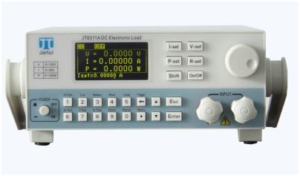
In today’s fast-paced world of electronics and power testing, efficiency is key. Whether you’re developing new power supplies, batteries, or other electronic devices, testing and validation play a crucial role in ensuring product performance. Programmable DC electronic loads have become an essential tool for engineers and technicians, providing precise control and accurate testing capabilities. This article will guide you on how to maximize efficiency using programmable DC electronic loads, ensuring reliable results and enhanced productivity.
What is a Programmable DC Electronic Load?
A programmable DC electronic load is a versatile testing instrument that allows users to simulate various load conditions on power sources, such as power supplies, batteries, or solar panels. Unlike traditional resistive loads, programmable DC loads can be dynamically adjusted to simulate real-world conditions like constant current, constant voltage, or constant power.
These loads are essential for testing the performance of devices under different operating conditions. They provide flexibility, precision, and the ability to replicate a wide range of real-world scenarios, helping engineers fine-tune their designs.
Key Benefits of Programmable DC Electronic Loads
Programmable DC electronic loads offer several advantages over traditional testing methods. These include:
- Precision and Accuracy: Programmable DC loads allow for highly accurate and repeatable tests, providing precise control over voltage, current, and power settings.
- Flexibility: These loads can simulate a variety of operating conditions, including constant current, constant voltage, constant power, and dynamic load profiles.
- Automation: Many programmable DC loads support automated testing, reducing human error and saving time during repetitive tasks.
- Cost-Effectiveness: By simulating real-world conditions, engineers can test multiple scenarios without needing to physically alter the load, reducing the need for additional equipment and resources.
How Programmable DC Electronic Loads Enhance Testing Efficiency
To maximize efficiency with programmable DC electronic loads, it is important to understand how they can streamline testing processes and reduce setup time. Here are some ways these devices improve efficiency:
1. Automation of Load Testing
One of the key advantages of programmable DC electronic loads is the ability to automate load testing. Traditional testing methods often require manual adjustments and monitoring, which can be time-consuming and prone to errors. With programmable loads, users can set parameters for testing (such as voltage, current, and power) and let the device run through the test cycle without manual intervention.
- Set the test parameters once, and the device automatically adjusts the load as required.
- Automate repetitive testing tasks to save time and reduce the chance of human error.
- Use built-in test sequences for common testing scenarios, reducing the need for complex programming.
2. Dynamic Load Simulation
Programmable DC electronic loads can simulate dynamic load conditions, which is essential for testing power supplies under real-world usage scenarios. This capability allows engineers to evaluate how their devices respond to varying loads, such as sudden changes in current draw or voltage fluctuations.
- Simulate real-world conditions like fluctuating current and voltage levels.
- Test power supplies under transient conditions, which are common in real-world applications.
- Fine-tune devices to ensure they perform optimally under varying loads.
3. Precise Control Over Testing Parameters
With programmable DC electronic loads, users have complete control over the testing parameters. This precision is essential for ensuring that devices meet performance specifications and regulatory requirements.
- Adjust voltage, current, and power settings with high precision.
- Use features like voltage or current limits to prevent damage to the device under test.
- Implement constant current, constant voltage, or constant power modes based on the test requirements.
4. Multiple Test Profiles and Configurations
Programmable DC electronic loads allow for the creation of multiple test profiles, making it easier to test a range of devices with different requirements. Engineers can store and recall configurations for different devices, ensuring that tests are consistent and repeatable.
- Store multiple test profiles for different devices or testing scenarios.
- Easily switch between profiles without needing to manually adjust settings.
- Conduct tests for a wide range of applications, from power supplies to batteries and renewable energy sources.
5. Data Logging and Reporting
Data logging is a critical feature for tracking the performance of devices over time. Programmable DC electronic loads can record test results, enabling engineers to analyze performance trends and make data-driven decisions.
- Automatically log test results for future analysis.
- Generate detailed reports for documentation and compliance purposes.
- Analyze trends in device performance to identify areas for improvement.
6. Safety Features
Safety is a top priority in any testing environment, and programmable DC electronic loads come equipped with built-in safety features to protect both the device under test and the testing equipment.
- Set overvoltage, overcurrent, and power limits to protect devices from damage.
- Automatically shut down or alert users in case of safety violations.
- Use remote control features to monitor tests from a safe distance.
Choosing the Right Programmable DC Electronic Load
To maximize efficiency, it is essential to choose the right programmable DC electronic load for your specific needs. Factors to consider include:
- Power Rating: Ensure that the load can handle the maximum power output of the device under test.
- Current and Voltage Range: Select a load with an appropriate range for your testing requirements.
- Test Features: Look for loads with features such as dynamic load simulation, multiple test profiles, and data logging.
- Ease of Use: Choose a device with a user-friendly interface and software support for easier operation.
For more detailed information on the specifications and features of programmable DC electronic loads, visit Technical Products’ Programmable DC Electronic Load page.
Conclusion
Programmable DC electronic loads are powerful tools that can significantly enhance the efficiency of testing and validation processes. By automating load testing, simulating dynamic conditions, and providing precise control over testing parameters, these devices help engineers optimize their designs and ensure product reliability. To maximize the efficiency of your testing procedures, consider investing in a programmable DC electronic load that suits your specific needs.
For more information on how programmable DC electronic loads can benefit your testing and validation process, explore the detailed specifications and features on Technical Products’ Programmable DC Electronic Load page.
By incorporating these advanced testing tools into your workflow, you can achieve faster, more accurate results and reduce the time spent on manual testing, ultimately improving the overall efficiency of your operations.
For more details on programmable DC electronic loads, check out Technical Products’ Programmable DC Electronic Load page.







